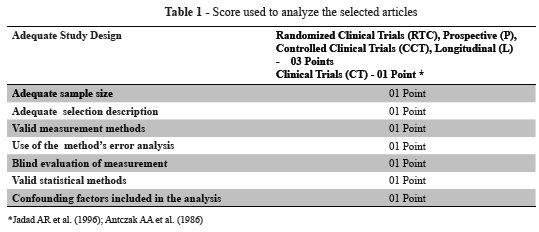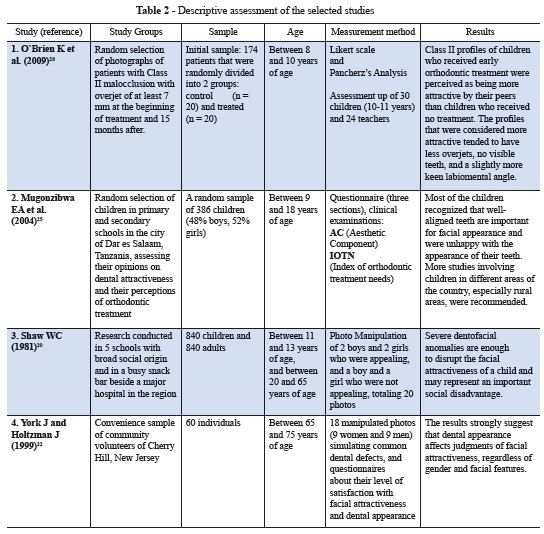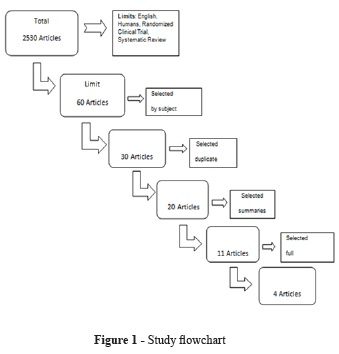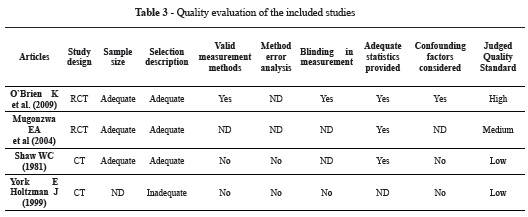Serviços Personalizados
Artigo
Links relacionados
Compartilhar
Arquivos em Odontologia
versão impressa ISSN 1516-0939
Arq. Odontol. vol.51 no.2 Belo Horizonte Abr./Jun. 2015
Societal perceptions of dentofacial appearances of patients with malocclusion: a systematic review
Percepção da sociedade sobre a aparência dento-facial de pacientes com má oclusão: revisão sistemática
Renata F PradoI; Carolina M S SiqueiraII; Joana Ramos-JorgeIII; Saul M PaivaII; Camilo A MelgaçoIV; Camila A PazziniIV
I Department of Orthodontics, Faculty of Dentistry, Vale do Rio Verde University (UNINCOR), Três Corações, MG, Brazil
II Department of Pediatric Dentistry and Orthodontics, Faculty of Dentistry, Federal University of Minas Gerais (UFMG), Belo Horizonte, MG, Brazil
III Department of Pediatric Dentistry and Orthodontics, Faculty of Dentistry, Federal University of Vales do Jequitinhonha e Mucuri (UFVJM), Diamantina, MG, Brazil
IV Department of Orthodontics, Faculty of Dentistry, UNINCOR, Três Corações, MG, Brazil
Contacts: re.fprado@yahoo.com.br, carolcm10@hotmail.com, smpaiva@uol.com.br, joanaramosjorge@gmail.com, camiloaquino@ig.com.br
ABSTRACT
Aim: This systematic review aimed to evaluate whether or not there is evidence enough to support the hypothesis that society promotes judgments on the facial aesthetics of individuals with malocclusion. Methods: Searches were conducted in the PubMed, Bireme, BBO, LILACS, Web of Science, EMBASE, Cochrane Library, and SciELO databases, supplemented by an additional manual search. Results: The present study included all articles that appeared in each of these databases between January 1965 and February 2015. Inclusion criteria were based on the articles whose primary focus was the societal perception of dentofacial appearances, written in English; observational and experimental epidemiological studies (Cross-sectional, Longitudinal, Cohort, Randomized Clinical Trial, Case-Control); and systematic reviews. Review articles, clinical case reports, laboratorial experiment studies, and abstracts were excluded. This search identified 2,530 articles, of which four fulfilled the inclusion criteria. Of these, only one study showed a high level of scientific evidence. The main flaws found included blind assessment of the measurement, validity of the measurement methods, error analysis of the method, and confounding factors not reported in all articles. Conclusion: According to this systematic review, it could be concluded that there is a need for further studies with more efficient methodological qualities.
Uniterms: Orthodontics. Malocclusion. Visual perception. Systematic review.
RESUMO
Objetivo: Avaliar se existem evidências que suportam a hipótese de que a sociedade promove julgamentos considerando a estética facial de indivíduos com má oclusão. Material e Métodos: Foram realizadas buscas nas bases de dados PubMed, Bireme, BBO, LILACS, Web of Science, EMBASE, Cochrane Library e Scielo, complementando por uma busca manual. Resultados: Foram incluídos todos os artigos que apareceram em cada uma destas bases de dados de janeiro de 1965 a fevereiro de 2015. Critérios de inclusão foram os artigos cujo foco principal era a percepção da sociedade em relação à aparência dento-facial, publicados em inglês, estudos epidemiológicos observacionais e experimentais (Transversal, Longitudinal, Coorte, Ensaio Clínico Randomizado e Caso-Controle) e revisão sistemática. Artigos de revisão, relatos de caso clínico, estudos laboratoriais e resumos foram excluídos. A busca bibliográfica identificou 2530 artigos e 4 preencheram os critérios de inclusão. Destes somente um estudo apresentou elevado grau de evidência científica. A avaliação cega da medição, a validade dos métodos de medição, a análise de erro de método e os fatores de confusão não declarados em todos os artigos, foram as principais falhas encontradas. Conclusão: De acordo com esta revisão sistemática, concluiu-se que há a necessidade de estudos com qualidades metodológicas mais eficientes.
Descritores: Ortodontia. Má oclusão. Percepção visual. Revisão sistemática.
INTRODUCTION
Facial aesthetics is a significant factor in societal perceptions and plays an important role in assessing personality and social acceptance1,2. The perception of appearance, especially facial, affects one's social behavior, with significant consequences in areas such as education, as well as one's professional and the affective life3,4,5.
Malocclusions can be considered a public health problem, since they have a high prevalence and can cause a social impact by interfering in the quality of life (QoL) of affected individuals6. Individuals with malocclusion (particularly in the anterior region) may require orthodontic treatment to improve oral health, dental function, and aesthetics, resulting in an improvement in one's QoL. Orthodontic treatment traditionally focuses on normative criteria, despite the fact that the psychosocial dimension has equal importance7.
Conditions that affect dental aesthetics influence one's psychological well-being and social interactions among Brazilian teenagers. Upper anterior crowding, a median diastema of less than 2 mm, a low socioeconomic level, and the normative need for orthodontic treatment (highly desirable) are factors that are directly involved in the aesthetic impact on one's QoL8.
In the last two decades, many measures, such as the Child Perceptions Questionnaire9 (CPQ), which is one of the instruments of the Oral Health-Related Quality of Life (OHRQoL) that has the enormous advantage of respecting the constant changes that occur during childhood and is consequently divided according to the age groups of 6-7, 8-10, and 11-14 years; the Psychological Impact of Dental Aesthetics Questionnaire (PIDAQ), which is a specific questionnaire used to assess the psychosocial impact of dental aesthetics in young adults from 18-30 years of age10; the OHRQoL questionnaire, which is used to determine individuals' impressions regarding their own health, given that it assesses the impact of oral conditions on one's QoL; among other such instruments, have been developed to evaluate the impact of oral health on one's QoL11,12. However, understanding the physical, social, and psychological impacts of malocclusion on one's QoL still requires further attention13,14.
Most studies developed regarding the aesthetic impact of individuals' facial appearances, associated with malocclusions, on their QoL discuss the involved individuals' perceptions12. However, studies addressing the societal perception and judgment placed upon individuals with malocclusion and changes in facial aesthetics are still poorly explored1. Thus, malocclusion may adversely affect an individual's social interactions and psychological well-being. Studies have revealed that individuals with malocclusion experienced a greater negative impact on OHRQoL than did those without malocclusion15.
Therefore, this systematic review aimed to evaluate whether or not there is sufficient evidence to support the hypothesis that society promotes judgments on the facial aesthetics of individuals with malocclusion.
METHODS
Search strategies
The relevant literature searches were conducted in the electronic databases of Pub Med, Bireme, BBO, LILACS, Web of Science, EMBASE, Cochrane Library, and SciELO, according to the following combinations of terms: 'malocclusion and quality of life', 'malocclusion and social judgment', 'malocclusion and facial attractiveness', 'malocclusion and facial attractiveness', 'malocclusion and the perception of beauty', 'malocclusion and visual perception', 'malocclusion and patient perception', 'facial perception and malocclusion', and 'malocclusion and facial aesthetics'.
The results included all articles published in English that have appeared in each of these databases, according to the terms cited above, from January 1965 to February 2015. The reference lists of selected articles were also researched manually for additional relevant publications that might have been missed in these data searches.
Selection criteria
Inclusion criteria were based on articles whose primary focus was the societal perception of the dentofacial appearances, published in English; observational and experimental epidemiological studies (Cross-sectional, Longitudinal, Cohort, Randomized Clinical Trial, Case-Control); and systematic reviews. Review articles, clinical case reports, laboratorial experiment studies, and abstracts were excluded.
Data collection and analysis
The data were organized considering the following items: author, year of publication, measures, study design, study groups, methods/ measures, and results. Trials of eligible studies, assessment of the methodological quality, and data extraction were performed. Quality assessment was conducted to document the methodological soundness of each article as regards pre-established characteristics16,17, evaluating eight main variables (Table 1).

Sample sizes were considered adequate when they presented a sample calculation. Measurement methods were considered valid when a test measurement error was displayed. Each study was classified according to their score as low (0-5 points), medium (6-8 points), or high (9-10 points)18.
Data extraction and quality score for each article was assessed independently by two trained and calibrated researchers, who selected the articles by reading the title and abstracts. All articles that appeared to comply with the inclusion criteria were selected. A high agreement was found among the researchers in this step (Kappa > 0.90). At this stage, the full articles were read by two raters in order to obtain a common assessment. When there was disagreement on the evaluation, the article was re-read, re-assessed, and resolved by discussion.
A systematic review was performed following the Preferred Reporting Items for Systematic Reviews and Meta-Analysis (PRISMA) recommendations19.
RESULTS
Following the search strategy, 2,530 papers were identified. After the selection, and based on the eligibility criteria, 60 articles were initially selected, 30 of which were related to the subject of study. After the removal of duplicate articles, 20 studies were selected, the summaries of which were read by both researchers, reaching a final sample of 11 articles. After a complete reading of these studies, four met all of the inclusion criteria and were selected for final analysis (Table 2). The full texts of these articles were obtained for analysis. (Figure 1).


The quality of research and methodological consistency was considered high in only one study. Two were classified as low and one as medium methodological consistency (Table 3).

DISCUSSION
According to the inclusion criteria, only four studies were selected for this systematic review. Among them, only one study presented a high level of scientific evidence. The main flaws found included the blind assessment of the measurement, the validity of the measurement methods, the method of error analysis, and the confounding factors not reported in all articles.
Children with dental appearance without changes would be judged more beautiful, more prone to friendships, smarter, and less aggressive2,20. One problem in this region immediately becomes a focus for observers, which noticeably modify their attitude, consequently generating psychosocial reactions in patients12,21.
The dental appearance affects judgments of facial attractiveness, regardless of the facial features and gender of the individual22. The malocclusions and dentofacial deformities significantly affect the aesthetics, masticatory function, and, consequently, an individual's social and psychological well-being23,24. Further, concern with personal appearance and physical attractiveness does not appear to decline with age22. No statistically significant differences were found between genders regarding the impact of malocclusion on OHRQoL, which is on accordance with some previous studies. However, gender has been described as a factor affecting the self-perception of dental appearance/malocclusion12.
Evaluating the opinions of children regarding their dental attractiveness and perception of orthodontic treatment concluded that most children recognize that well-aligned teeth are important for facial appearance and that they were unhappy with the appearance of their teeth. According to the authors, more studies involving children from different areas of the country, especially rural settings, are recommended25, confirming that the social implications of malocclusion often occur, given that the dentofacial complex is the most important component of communication and interpersonal relations12.
Some studies have reported that perceptions of malocclusion do not differ among various racial groups and cultural circumstances; however, African people living in Africa can have different malocclusion perceptions when compared to other societies. For example, spacing (especially median diastema) is significantly disliked in white cultures, but it is considered desirable and a sign of beauty in many African cultures26,27. Although our results might reflect cultural and educational differences, other explanations could be that the frequency of malocclusion in the Tanzanian population is low, whereas orthodontic treatment, which can increase orthodontic awareness, is uncommon25.
One study was performed to assess whether or not treatment with a twin-block functional appliance in children of 8-10 years of age (in the transitional dentition) improves the attractiveness of a class II profile and determines the orofacial characteristics of a profile that more commonly influences the perception of attractiveness. The results show that children with Class II malocclusion, who received early orthodontic treatment, were considered more attractive by their peers than were children who received no treatment28. The profiles that were considered more attractive tended to have smaller overjets, no visible teeth, and slightly more acute labiomental angle29.
Future studies need a more consistent design methodology, with adequate sample sizes, together with sample calculations and the standardization of evaluation methods, such as the reuse of the same questionnaires and the performance of randomized clinical trials, while minimizing possible bias and strengthening scientific evidence of the results.
CONCLUSION
This review suggests that there is an association between malocclusion/orthodontic treatment needs and one's QoL, and that they coexist in the same population. Studies with more efficient methodological qualities, thus producing greater scientific evidence, are warranted in an attempt to facilitate the comparison of trial results.
ACKNOWLEDGEMENTS
This study was supported by the Research Foundation of the State of Minas Gerais (FAPEMIG), the National Council of Technological and Scientific Development (CNPq), and the Brazilian Coordination of Higher Education from the Brazilian Ministry of Education (CAPES).
REFERENCES
1. Cadena SMD, Guerra CMF. Facial appearance and the ideal image. Rev. Dent. Press. Estética. 2006; 3:27-38. [ Links ]
2. Marques LS, Filogônio CA, Filogônio CB, Pereira LJ, Pordeus IA, Paiva SM, et al. Aesthetic impact of malocclusion in the daily living of Brazilian adolescents. J. Orthod. 2009; 36(3):152-9.
3. Shaw WC, Lewis HG, Robertson NRE. Perception of malocclusion. Br. Dent. J. 1975; 138(6):211-7.
4. Peres KG, Traebert ESA, Marcenes W. Diferenças entre autopercepção e critérios normativos na identificação das oclusopatias. Rev. Saúde Pública. 2002; 36(2):230-6.
5. Maltagliati LA, Montes LAP. Análise dos fatores que motivam os pacientes adultos a buscarem o tratamento ortodôntico. Rev. Dent. Press. Ortodon. Ortoped. Facial. 2007; 12(6):54-60.
6. Dracker HL. Handicapping labio-lingual conditions: proposed index for public health purposes. Am. J. Orthod. 1960; 46(4):295-305.
7. O'Brien K, Wright J L, Conboy F, Macfarlane T, Mandall N. The child perception questionnaire is valid for malocclusions in the United Kingdom. Am. J. Orthod. Dentofacial Orthop. 2006; 129(4):536-540.
8. Marques LS, Filogônio CA, Filogônio CB, Pereira LJ, Pordeus IA, Paiva SM, et al. Aesthetic impact of malocclusion in the daily living of Brazilian adolescents. J. Orthod. 2009; 36(3):152-9.
9. Jokovic A, Locker D, Tompson B, Guyatt G. Questionnaire for measuring oral health-related quality of life in eight-to ten-year old children. Pediatr. Dent. 2004; 26(6):512-8.
10. Klages U, Claus N, Wehrbein H, Zentner A. Development of a questionnaire for assessment of the psychosocial impact of dental aesthetics in young adults. Eur. J. Orthod. 2006; 28(2):103-11.
11. Broder HL, McGrath C, Cisneros GJ. Questionnaire development: face validity and item impact testing of child oral health impact profile. Community Dent. Oral Epidemiol. 2007; 35(1):8-19.
12. Liu Z, Mcgrath C, Hägg U. The impact of malocclusion/orthodontic treatment need on the quality of life. A systematic review. Angle Orthod. 2009; 79(3):585-91.
13. Hassan AH, Amin Hel-S. Association of orthodontic treatment needs and oral healthrelated quality of life in young adults. Am. J. Orthod. Dentofacial Orthop. 2010; 137(1):42-7.
14. Broder HL, McGrath C, Cisneros GJ. Questionnaire development: face validity and item impact testing of child oral health impact profile. Community Dent. Oral Epidemiol. 2007; 35(1):8-19.
15. Sardenberg F, Martins MT, Bendo CB, Pordeus IA, Paiva SM, Auad SM, et al. Malocclusion and oral health-related quality of life in Brazilian school children. Angle Orthod. 2013; 83(1):83-9
16. Antczak AA, Tang J, Chalmers TC. Quality assessment of randomized control trials in dental research. J. Period. Res. 1986; 21(4):305-14.
17. Jadad AR, Moore RA, Carroll D, Jenkinson C, Reynolds DJ, Gavaghan DJ, et al. Assessing the quality of reports of randomized clinical trials: is blinding necessary? Control. Clin. Trials. 1996; 17(1):1-12.
18. Andrade A. da S, Gameiro GH, Derossi M, Gavião MB. Posterior crossbite and functional changes. A systematic review. Angle Orthod. 2009; 79(2):380-6.
19. Liberati A, Altman DG, Tetzlaff J, Mulrow C, Gotzsche PC, Ioannidis JPA, et al. The PRISMA statement for reporting systematic reviews and meta-analyses of studies that evaluate health care interventions: explanation and elaboration. Ann. Intern. Med. 2009; 151(2):65-94.
20. Shaw WC. The influence of children's dentofacial appearance on their social attractiveness a judged by pears and lay adults. Am. J. Orthod. 1981; 79(4):309-14.
21. Bernabé E, Sheiham A, Tsakos G, Messias de Oliveira C. The impact of orthodontic treatment on the quality of life in adolescents: a case-control study. Eur. J. Orthod. 2008; 30(6):515-20.
22. York J, Holtzman J. Facial attractiveness and the aged. SCD. 1999; 17:84-8.
23. Chen M, Wang DW, Wu LP. Fixed orthodontic appliance therapy and its impact on oral healthrelated quality of life in Chinese patients. Angle Orthod. 2010; 80(1):49-53.
24. Feu D, Oliveira BH, Oliveira Almeida MA, Kiyak HA, Miguel JA. Oral health-related quality of life and orthodontic treatment seeking. Am. J. Orthod. Dentofacial Orthop. 2010; 138(2):152-9.
25. Mugonzibwa EA, Kuijpers-Jagtman AM, Van't Hof MA, Kikwilu EN. Perceptions of dental attractiveness and orthodontic treatment need among Tanzanian children. Am. J. Orthod. Dentofacial Orthop. 2004; 125(4):426-34.
26. Kerosuo H, Hausen H, Laine T, Shaw WC. The influence of incisal malocclusion on the social attractiveness of young adults in Finland. Eur. J. Orthod. 1995; 17(6):505-12.
27. Burden DJ, Pine CM. Self-perception of malocclusion among adolescents. Community Dent. Health. 1995; 12(1):89-92.
28. O'Brien K, Macfarlane T, Wright J, Conboy F, Appelbe P, Birnie D, et al. Earyl treatment for Class II malocclusion and perceived improvements in facial profile. Am. J. Orthod. Dentofacial Orthop. 2009; 135(5):580-5.
29. O'Neill K, Harkness M, Knight R. Ratings of profile attractiveness after functional appliance treatments. Am. J. Orthod. Dentofacial Orthop. 2000; 118(4):371-6.













